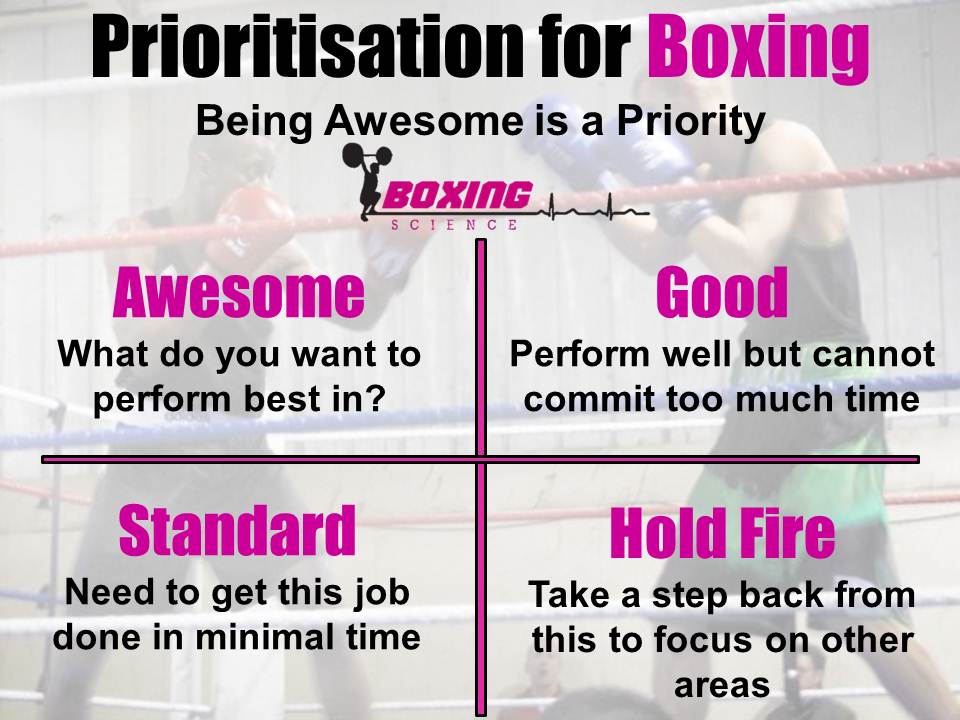Prioritisation for Boxing
Boxing is a sport like no other. A professional fighter will often train 2-3 times a day, but will still need time to work or study, which is quite commendable. Some are fortunate enough to be in boxing training full time, still have to manage media, sponsors, community and family commitments.
Ok, we prioritise training too. But how many areas do boxers need to cover?
- Boxing Training – sparring, technique, footwork, skipping, pads, bags, strategy, tactics, opponent research
- Fitness Training – high intensity conditioning, strength training, mobility
- Nutrition – diet planning, food shopping, food preparation, supplements
- Recovery methods – sleep, active recovery, foam rolling, ice bath, compression garments, physio, sports massage
- Psychology – imagery, centering, daily preparation, relaxation
The list can go on. But then the questions are…
“What do I prioritise? When do I do this training camp? What time of day? How long should I spend? In what order?”
Who’d have thought this goes on for 10 plus weeks for just a maximum of 36 minutes in the ring?
Boxers have to manage various responsibilities, making prioritisation an important process.
Here I will recycle my own blog post from my personal blog Wilson Strength sharing useful prioritisation methods I have used with athletes and for my own career.
Prioritisation is about balance
I have been so busy I do not know where the past 4 years have gone. At various points I will have worked 14+ days without rest with the combination of working commitments, studying, various internships, developing excel programs and numerous online resources. A lot of these days being at least 12 hours.
With so much happening, it becomes difficult to maintain work-life balance and keeping everything in check. There is nothing to gain by rushing everything to do a standard/poor job just to get everything done, as they say ‘quality over quantity’. This is where prioritisation becomes an important method to use in your development.
How important is this to me right now?
Trying to juggle several priorities with the same amount of effort and time you become ‘a jack of old trades, master of none’. You need to chose what is important, what is urgent, what you want to be awesome at and what is the total opposite.
I have come across this simple but useful tool a few times from colleagues or at university. It is a to do list quadrant, you list each task you need to do in the appropriate square, managing your time effectively to ensure the Important and Urgent get done first.
I like this process and I would encourage you to use it to manage your priorities, but I do not love it. I feel that if it is urgent, it instantly becomes important and visverca.
Being awesome is a priority
I have developed my own version of the quadrant (see below). The quadrant is designed to organise activities in a category dependent on what quality of work you want to produce.
Rather than listing speculative boxing specific examples, I will demonstrate how I used this process during my MSc project testing in 2014. 
During this time period, the main priority was to be Awesome at organising and delivering the testing sessions. I knew this was going to be time consuming, therefore had to decide the quality requirements of other work as I could not invest the time to make it all awesome.
Reviewing and feeding back the data was an important task, but something I couldn’t commit too much time to as I needed to optimise the efficiency of the testing, therefore this was categorised under Good.
I also did a Good job on the media output as this was important to raise awareness of the testing to recruit participants. I had to maintain other activities such as continuing MSc assignments and reading that just needed to be chipped away at, but time spent on this had to be minimal to perform to Standard.
Sometimes you may have to Hold Fire on activities. This is needed put to one side as you need to invest your time on other projects – in this case I booked time off work and internships so I could focus on the task in hand.
This process has been useful, and can be adapted to yearly, monthly, weekly or even daily plans.
Give it a go
Boxers should use this tool to manage their various commitments. Boxing is obviously high on the agenda most of the time, but as your closer to a fight maybe you need to put things lower on the agenda, making sure you are awesome at boxing.
Here is a blank quadrant, click it, print it off, fill it in and send it to us over twitter @BoxingScience_ , Facebook or e-mail boxing.sci@gmail.com



